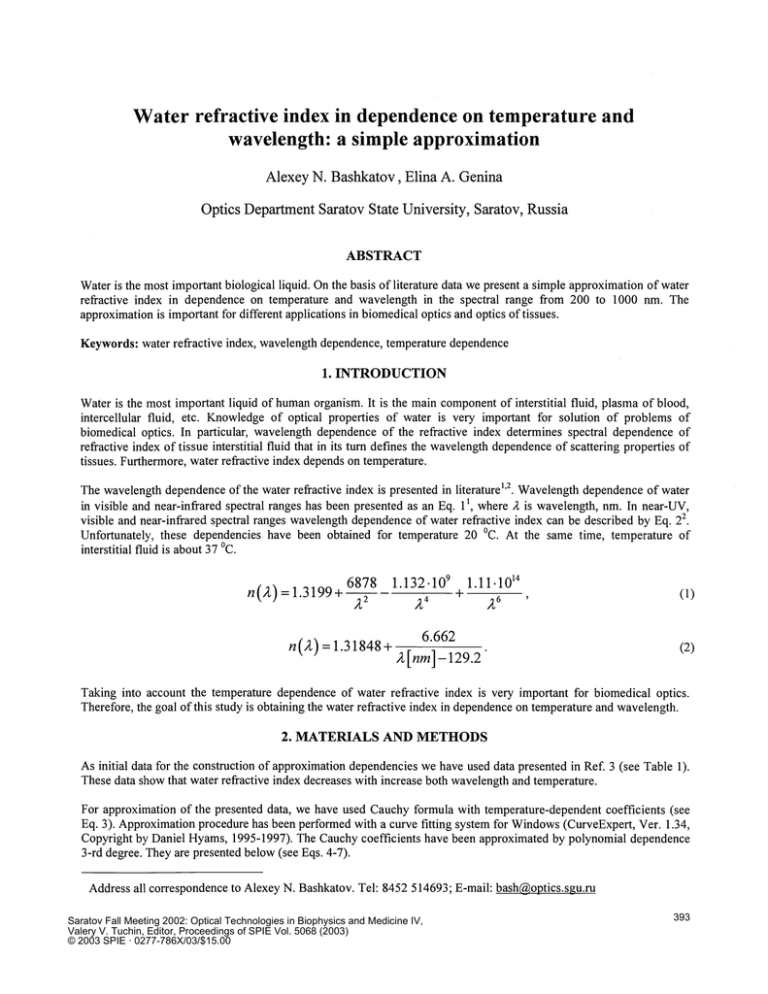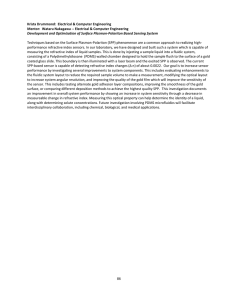Water refractive index in dependence on temperature and
advertisement

Water refractive index in dependence on temperature and wavelength: a simple approximation Alexey N. Bashkatov , Elina A. Genina Optics Department Saratov State University, Saratov, Russia ABSTRACT Water is the most important biological liquid. On the basis of literature data we present a simple approximation of water refractive index in dependence on temperature and wavelength in the spectral range from 200 to 1 000 nm. The approximation is important for different applications in biomedical optics and optics of tissues. Keywords: water refractive index, wavelength dependence, temperature dependence 1. INTRODUCTION Water is the most important liquid of human organism. It is the main component of interstitial fluid, plasma of blood, intercellular fluid, etc. Knowledge of optical properties of water is very important for solution of problems of biomedical optics. In particular, wavelength dependence of the refractive index determines spectral dependence of refractive index of tissue interstitial fluid that in its turn defines the wavelength dependence of scattering properties of tissues. Furthermore, water refractive index depends on temperature. The wavelength dependence of the water refractive index is presented in literature1'2. Wavelength dependence of water in visible and near-infrared spectral ranges has been presented as an Eq. 1 , where 2 is wavelength, nm. In near-UV, visible and near-infrared spectral ranges wavelength dependence of water refractive index can be described by Eq. 22. Unfortunately, these dependencies have been obtained for temperature 20 °C. At the same time, temperature of interstitial fluid is about 37 °C. n(2)=1.3199+ 6878 — 1.1321O i.ii.iO' + a2 A4 26 (1) 6.662 n(2)=1.31848+ (2) 2[nm]—129.2 Taking into account the temperature dependence of water refractive index is very important for biomedical optics. Therefore, the goal ofthis study is obtaining the water refractive index in dependence on temperature and wavelength. 2. MATERIALS AND METHODS As initial data for the construction of approximation dependencies we have used data presented in Ref 3 (see Table 1). These data show that water refractive index decreases with increase both wavelength and temperature. For approximation of the presented data, we have used Cauchy formula with temperature-dependent coefficients (see Eq. 3). Approximation procedure has been performed with a curve fitting system for Windows (CurveExpert, Ver. 1.34, Copyright by Daniel Hyams, 1995-1997). The Cauchy coefficients have been approximated by polynomial dependence 3-rd degree. They are presented below (see Eqs. 4-7). Address all correspondence to Alexey N. Bashkatov. Tel: 8452 514693; E-mail: bashCoptics.sgu.ru Saratov Fall Meeting 2002: Optical Technologies in Biophysics and Medicine IV, Valery V. Tuchin, Editor, Proceedings of SPIE Vol. 5068 (2003) © 2003 SPIE · 0277-786X/03/$15.00 393 B(t) C(t) D(t) n(2,t)=A(t)+ ,2 + 2 + 26 where (3) , is wavelength, nm; and A (t) , B (t) , C (t) , D (t) are the Cauchy coefficients presented as a function of temperature; t is temperature, °C. Table 1 . The water refractive index in dependence on temperature and wavelength3. Temperature, °C 226.5 nm 361.05 nm Wavelength 404.41 nm 589 nm 632.8 nm 1013.98 nm 0 1.3945 1.34896 1.34415 1.33432 1.33306 1.32612 10 1.39422 1.3487 1.34389 1.33408 1.33282 1.32591 20 1.39336 1.34795 1.34315 1.33336 1.33211 1.32524 30 1.39208 1.34682 1.34205 1.3323 1.33105 1.32424 40 1.39046 1.3454 1.34065 1.33095 1.32972 1.32296 50 1.38854 1.34373 1.33901 1.32937 1.32814 1.32145 60 1.38636 1.34184 1.33714 1.32757 1.31974 70 80 90 1.38395 1.33974 1.33508 1.38132 1.33746 1.33284 1.32559 1.32342 1.32636 1.32438 1.37849 1.33501 1.33042 100 1.37547 1.33239 1.32784 . . . . . Relative error has been obtained from following relationship: s = kiab1e 1.32223 1.31784 1.31576 1.32109 1.31991 1.31353 1.31861 1.31744 1.31114 ca1c , where . . iab/e i5 water refractive index tab1e presented in Table 1 , and calc is water refractive index calculated with our approximation. 3. RESULTS AND DISCUSSION Using the data presented in Table 1 we have approximated spectral dependence of water refractive index by the Cauchy formula for each temperature. Obtained coefficients are presented in Table 2. Table 2. The Cauchy coefficients obtained from calculations. Temperature, °C A B Cx 1 08 D 0 1.32074 5207.924 -2.55522 9.35006 7.5467 10 1.32051 5200.71 -2.55787 9.37275 7.46308 20 1.31984 1.31885 5190.553 5173.8657 5154.7658 5134.0393 -2.56169 9.39388 -2.56817 9.43261 -2.5756 -2.58372 9.47474 9.51384 7.45798 7.37812 7.50379 7.3477 30 40 50 60 1.3176 1.31609 Mean relative error x 1 O 1.31438 5109.635 -2.59321 9.56139 7.27287 70 1.31249 5083.2735 -2.60364 9.61276 7.12462 80 1.31044 1.30821 1.30587 5057.2226 5028.0151 4997.0391 -2.61394 -2.62537 -2.63769 9.65879 9.71071 9.76828 7.2006 7.0504 7.17674 90 100 Using coefficients presented in Table 2 we have obtained temperature dependence of each coefficient (see Eq. 4-7). 394 Proc. of SPIE Vol. 5068 A(t)=1.3208—1.2325.105t—1.8674.106t2+5.0233.109t3 (4) B(t)=5208.2413—O.5179t—2.284.102t2+6.9608.105t3 (5) C(t) = —2.5551 .108 —18341.336t —917.2319t2 +2.7729t3 (6) D(t) = 9.3495+1.7855•103t+3.6733•105t2 —1.2932•107t3 (7) ACKNOWLEDGEMENTS The research has been done due to financial support of grant 'Leading Scientific Schools' No. 00-15-96667 of the Russian Basic Research Foundation and by Award No. REC-006 of the U.S. Civilian Research & Development Foundation for the Independent States of the Former Soviet Union (CRDF). REFERENCES 1. M. Kohl, M. Esseupreis, M. Cope, "The influence of glucose concentration upon the transport of light in tissuesimulating phantoms," Phys. Med. Biol. 40, pp. 1267-1287, 1995. 2. P.O. Rol, Optics for transscleral laser applications, Ph.D. Dissertation: Swiss Federal Institute of Technology, Zurich, Switzerland. ETH N. 9665, 1991. 3. Index of refraction of water / Handbook of Chemistry and Physics, Eds. Lide D.R., CRC Press LLC, 2000-2001. Proc. of SPIE Vol. 5068 395



